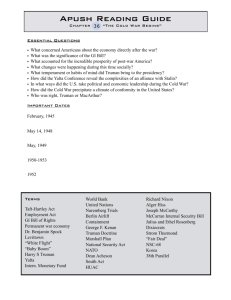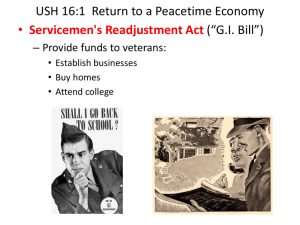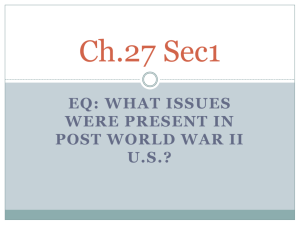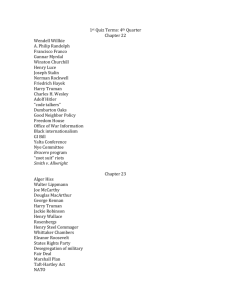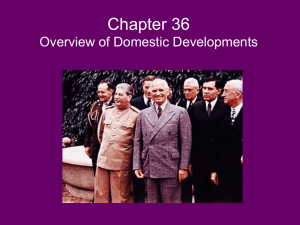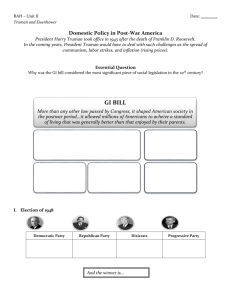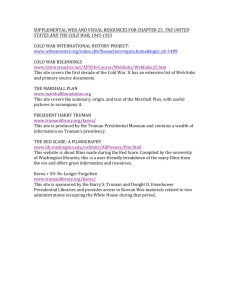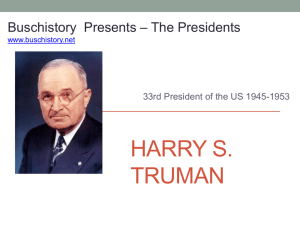Introduction - The Truman Show
advertisement
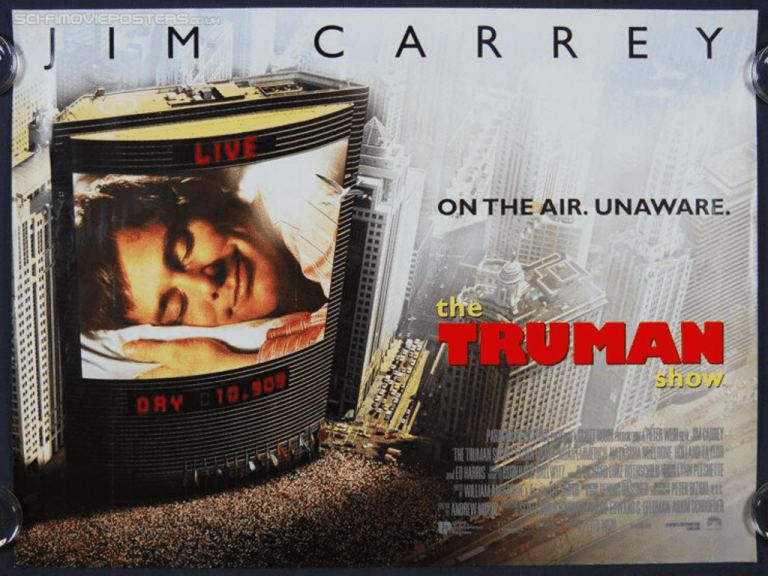
The Truman Show (1998) • Key Facts • The Truman Show (1998) Directed by Peter Weir and Starring Jim Carrey as Truman Burbank • Certificate = Parental Guidance (PG) • Running time = 103 minutes • Release date = October 9th 1998 • Budget = $60, 000, 000 • Gross = $264, 000, 000 • Distribution company = Paramount Pictures, Paramount Home Entertainment, • Production company – Scott Rudin Pictures The Truman Show (1998) • Certificate = Parental Guidance (PG) – General viewing, but some scenes may be unsuitable for young children. Unaccompanied children of any age may watch. A “PG” film should not disturb a child aged around eight or older. However, parents are advised to consider whether the content may upset younger or more sensitive children. • Theme More serious issues may be featured, e.g. crime, domestic violence, racism (providing nothing in their treatment condones them). Language Mild bad language only. Nudity Natural nudity, with no sexual context. Sex Mild sexual references and innuendo only. Violence Some violence, without detail, may be allowed. Imitable techniques No glamorization of realistic weapons. No detail of fighting or other dangerous techniques. Horror Frightening sequences should not be long or intense. Drugs No references to illegal drugs. The Truman Show (1998) • The Truman Show (1998) is a film which charts the life of Truman Burbank, a boy adopted at birth by a fictitious television company - Omnicom. • He is filmed twenty-four hours a day, seven days a week, three hundred and sixty-five days a year so every second of his life is recorded for ‘live’ television. • Truman doesn’t know this. He doesn’t know that his friends and family are all actors. • He doesn’t know that the events in his life are all carefully monitored and controlled by the production crew of the television network. • He doesn’t know he is the star of a television show nor that he isn’t living in the real world. • Peter Weir, the director, commented that he thought of the film as taking place twenty years or so in the future. • However, in the search for new scheduling ideas and greater audience figures, television networks become increasingly involved in filming the lives of ordinary people as television entertainment with the launch of Big Brother only two years after the release of the film. The Truman Show (1998) - Discuss • Having read this do you want to see the film? What is it particularly that interests you? • Do you agree with the concept of ‘The Truman Show’ and reality television shows in general? What moral and ethical problems do you see with making a programme of this nature? • What practical problems might there be? • Why do you think reality styled television has remained so popular over the years? The Truman Show (1998) • The film is like a mirror in that it is ‘self-reflective’ – it reflects whatever is in front of it. This movie is about its subject – Truman – but it is also the whole process of representing ‘reality’ in images • The film is a satire – it offers a critique of the way the media manipulates us and the way we participate in the media as willing spectators (by way of escapism, voyeurism and identification or vicarious experience) • It asks us to think about how much we can trust television, even shows which are supposedly ‘real’ – and also how much we have made the simulated ‘reality’ of television part of our everyday lives The Truman Show (1998) • The film is like a mirror in that it is ‘self-reflexive’ – it reflects whatever is in front of it. This movie is about its subject – Truman – but it is also the whole process of representing ‘reality’ in images • Medium – live action film • Genre – The film is a satire and critiques three well known specific genres: documentaries, popular American soap operas or sitcoms and reality television The Truman Show (1998) • The Documentary • The first genre type is documentary. Think of the beginning of the film where three principal participants (who are all fictional remember) talk to the audience directly – looking into the camera lens. They appear to be telling the ‘truth’ • Yet the film undercuts their remarks – for the rest of the story establishes quite clearly that their claim for authenticity is false. Truman’s life is NOT ‘all real’ and the assertion that ‘there’s nothing fake’ about the show is ludicrous. The authenticity they speak is bogus. • Discussion Point - What is the overall effect of such undercutting? To make us analyse the whole idea of representation s made on television. Who is telling the truth? Who is lying? How much can we trust what media people say? The Truman Show (1998) • The Documentary • Recent television documentary programmes have continued a long tradition of attempting to show real life in documentaries. This generates debate about the responsibility of filmmakers and the representation of the subject. • Throughout the history of the moving image audiences have been fascinated by the idea of film depicting the real lives of ‘other people’ at work or in the home. One of the earliest documentaries, ‘Nanook of the North’ by Flaherty (1921), depicted Eskimo life with the help of local participants. Owing to the constraints of the handheld camera, insensitive film stock requiring artificial light, and appalling weather conditions, Flaherty had to ask his subjects to do their normal activities in special ways and at special times. Because the Eskimos knew that Flaherty was helping them to place on record a vanishing way of life they provided and influenced the contents. • The events of this film were manipulated, and the film was a huge success with audiences who were keen to find out about the minutiae of other peoples’ lives. The Truman Show (1998) • The Documentary • Since those early days of documentary film-making, techniques and styles have evolved along with the introduction of new technology, such as smaller and more sophisticated cameras and sound equipment which allow the subjects to be less aware of the filmmaking process. • ‘The Truman Show’ is supposedly made with the help of 5,000 cameras controlled by Christof the mastermind, creator, producer and director. • Christof, from his mammoth control room, is the godlike figure who monitors, manoeuvres and manipulates Truman’s environment. • The control of the production of the television documentary and the effect on the audience is central to the debate about the responsibility of programme-makers. Michael Rabiger “Directing the Documentary” (1992) The Truman Show (1998) - Discuss • The Documentary • According to Michael Rabiger in his book ‘Directing the Documentary’ (published by Focal Press, 1992) there are three types of documentary. • Task 1 - Which of the three definitions shown applies to ‘The Truman Show’? Explain how you hove come to this decision. • 1. Those produced to give a definite message to the audience and therefore only give a one-sided view of the subject. These programmes are usually produced by an advertiser or a political group. • 2. Both sides of a story are given equal coverage in the telling of a story to an audience that needs to be educated and entertained. • 3. Programmes made to show the complexities of human life whereby the audience is engaged in making difficult judgements about the programmemakers’ quest for truth in portraying a real life situation. The Truman Show (1998) • The Documentary • The idea of Truman being an unwitting subject of the television programme has some parallels with the production of the television documentary made in 1963 called ‘7Up’. • The programme took as its inspiration the Jesuit saying, “Give me a child until he is seven and I’ll show you a man. The programme-makers took fourteen children from a cross-section of society and filmed them at seven-year intervals with the objective of finding out the extent to which a child’s future is determined by their social class. • 42Up’ intercut footage from previous programmes alongside recent interviews with the participants. Several of the original participants are no longer involved in the programme, with one member leaving in 1990 making the following statement: “I have had enough of being used for small screen entertainment...the images of myself and of the other children have been simplified to the point where they have become false. Please don’t think the programmes tell you anything about me. If you want the truth turn off the television and come to Liverpool.” • In a similar way to Truman Burbank, these participants who co-operated with the programme-makers were only children in the beginning and had no idea of the dramatic affect their participation, at seven-year intervals, would have on their lives. As adults they are now concerned that representations of them shown by the programmes is not accurate. The Truman Show (1998) • The Documentary • The recent glut of television documentary soaps such as, ’Big Brother’, ‘Geordie Shore’ and ‘Jersey Shore’, ‘Coach Trip’, ‘Hotel - The Adelphi’, ‘Driving School’, ‘The Cruise’, ‘Airport’ and many others have put the spotlight on many areas of life, making the ‘woman/man on the street’ the celebrity. • The programme about the Hotel Adelphi and the learner driver saw real people becoming celebrities through television exposure. • These programmes combine elements of soap operas as storylines with the characters being followed from one week to the next. • There are elements of documentary-style television as the camera follows the subject in a seemingly unobtrusive way allowing them to behave in a naturalistic manner. • This genre is relatively cheap television depicting real people, not actors and actresses who will need to be paid. They are also extremely popular and therefore guarantee high audience ratings and advertising revenue. The Truman Show (1998) • • The Documentary – Imagine that you had been involved in the making of a television programme like ‘7Up’. How have you changed since you were seven in terms of your looks, behaviour and opinions? • To help you in this task, at home look at photographs of yourself when you were born or were young, when you were around the age of seven and finally around the age of fourteen. • Ask parents and guardians about what you were like at those ages. • If you knew you were to be filmed roughly every seven years how might this affect what you choose to do with your life, both in terms of your career and personal life. • How do you think you would act if you were filmed twenty four hours a day for a show like ‘Big Brother’? Do you think you would be 100% natural? Justify your response to the latter question. • Compile a list (with examples of behaviour) of people who have become celebrities due to reality exposure and how it has affected them in a positive and negative way The Truman Show (1998) • Soap Opera / Sitcom • The second genre type may not be immediately obvious, but think about the way the film represents its characters. Everyone lives in a picture-perfect town called Seahaven, the sort of idyllic American town Walt Disney would have built. • In this ‘perfect’ town, all the streets are clean, the lawns are cut, people smile and all is sweetness and light. Look at Meryl’s hair- blond and perfectly coiffed. Think of the names of the bridesmaids – Jodie, Jean and Joanne – of the wedding photos, the childhood album, and so on. • In most traditional (especially 1950s, 1960s, 1970s and 1980s) sitcoms or soap operas, everyone is beautiful. They live in picture perfect places. • In sitcoms they are terribly nice, terribly tolerant, terribly wise, and all problems are solved by the final scene of each episode. In soap operas, they are not all terribly nice, but they are all beautiful and live luxurious lives The Truman Show (1998) • Reality Television • The third genre is reality television. Ironically, since the film was made in 1998, the genre has only become more popular and more extreme. Why do you think this is? • The Truman Show (1998) anticipates the worst excess of television series including The Bachelor, Survivor, Big Brother, Jersey Shore and so forth. The Truman Show (1998) • Morality and Ethics • There are issues of human rights and ethics of programme-making which are at the heart of The Truman Show (1998) with which the audience can identify. • These are the same issues which are at the heart of representing any ‘real’ people on television. Infringement of the rights of the individual within these television programmes is a major concern. • In the UK, the Broadcasting Standards Commission (now Ofcom), is an independent body set up to protect the rights of the individual and considers complaints of unfair treatment or unwarranted infringement of privacy while monitoring matters of taste and decency. The Truman Show (1998) • Morality and Ethics • In their annual review the Broadcasting Standards Commission expressed concern about the recent spate of docu-soaps and programmes made by viewers themselves. “1997 was undoubtedly the year of the documentary. Many are pretty light-hearted but from time to time they raise important issues worth wider discussion, not least, whether they are truthful.” • There is no doubt that many television viewers are keen to watch someone else’s daily life story. Therefore, there can be little doubt that many who choose to take part are happy to be included. The Truman Show (1998) - Discuss • Morality and Ethics • It is sometimes easy for broadcasting professionals, for whom television is a daily experience, to forget that for many others contact with the production process and appearance on the screen is a once-in-a-lifetime experience that they might live to regret. • Do you think that they always understand what they are getting into? Justify your response. • Do they appreciate what the consequences might be? • Have they given truly informed consent? Can you think of any examples to that would highlight this? The Truman Show (1998) • Morality and Ethics • In all television interviews or footage the participants are asked to complete a ‘release form’ which gives their consent for the footage shot to be used in a programme. These forms are legally binding and are completed to protect the programme-makers from any legal action that may arise. • The footage is edited and whilst the single uncut shot of events might be as an unbiased record of events, as soon as two shots are put together they could create a false impression. Every cut in a film makes a claim that two things are related in some way but in fact are not. • The production of a one-hour documentary involves 30-40 hours of original filming which means that a great deal is not shown. The decision to select what is shown and how it is edited is in the hands of the director. The Truman Show (1998) • Morality and Ethics • If the participants were aware of the ‘broadcast use’ would they allow themselves to be filmed carrying out their daily activities? • As mentioned before, a recent example of this was the second series of the extremely popular BBC series ‘Hotel’. • Britannia Hotels, the owners of the Adelphi Hotel in Liverpool, wanted editorial control of what went into the series which was seen by the BBC to tip the balance of the programme from being an ‘honest documentary’ to a ‘corporate video’ for the hotel chain. The Truman Show (1998) • Morality and Ethics • Group Task • Imagine a program similar to The Truman Show (1998) is currently being broadcast on UK television. • In groups make a list geared towards the Broadcasting Standards Commission (Ofcom) explaining what you think are the main arguments against the programme. The Truman Show (1998) • Morality and Ethics • Group Task • If Marist College was approached and asked to allow a television series to be made about it do you think the filming would be allowed? If not what would the reasons be? Discuss and note down your responses as a group. • Imagine you were producing a documentary programme about Marist. Construct a brief idea for a television programme that shows the school in a) a positive light and b) a negative light. • What sets, characters, conversations would you use? • Which characters in your school do you think would become celebrities? “What if everybody is just an actor in my story?” Jim Carrey. ‘We are always actors playing someone else this is just an extra step.” Noah Emmerich who plays Marlon. The Truman Show (1998) - Discuss • The world of The Truman Show (1998) – Discussion Points • Do you believe these two statements? Explain your reasons for believing or not believing them. • If you could construct a perfect world for yourself what would it be like? Think very carefully about this. What would it look like? For instance, would you want the sun to always shine? • You have been asked to construct a trailer for ‘The Truman Show’. Which elements of the film would you choose to present it as a film with a message? Which elements would you use to construct a comedy trailer? Which would be the most accurate representation of the film? • Which target audience do you think will be interested in this film? The Truman Show (1998) - Discuss • The world of The Truman Show (1998) – Discussion Points • What do you believe is the main message(s) of The Truman Show (1998) ? • Explain and comment in detail upon the following statement, “The Truman Show is a metaphor for our own situation.” Think about our influence by and relationship with the media. • In what ways do the audience identify with Truman? • Explore and explain the different ways that the film is a satire upon us – the audience? How are we represented? The Truman Show (1998) • Reality • It is obviously key to remember that the film is a piece of fiction and is therefore not real. Yet everyone who watches it recognises how neatly it satirises the reality television trend was well as the notion of spectatorship and celebrity worship • The film is a simulation of reality – just like the shoes it mocks and critiques. It represents a part of the real world in exaggerated form. • This is also known as hyper-reality – meaning experiencing a virtual or simulated reality (interacting with it as if it were real, though knowing it is constructed). Think of Disneyland as a good example of hyperreality. Can you think of any other examples of this hyper-reality in the real world? The Truman Show (1998) • Representation and Reality • The representation and the real are two different things, and The Truman Show (1998) reveals how the media confuse them, to the point where people do not know any more what is real and what is constructed • In doing this it asks us to think long and hard about how accurate all representations of reality are • Truman’s life is completely set up the consumption of the television audience, in very much the way a real life show like Big Brother sets up an experiment in reality for the pleasure of the audience • Christof famously states, There’s nothing fake about The Truman Show and Marlon adds, ‘It’s all real’ – but Peter Weir invites his audience to oppose these claims The Truman Show (1998) • Illusion of the Media • The film is a brilliant expose of the illusion (construction of reality) wrapped up in the process of making film and television products. Some of the most dramatically exposed elements are: • Set Design – as illusion (the life scene and the final sailing sequences with the cyclorama wall) • Special Effects – such as the fire (the road out of Seahaven), rain (Truman on the beach), the storm at sea, and especially the sunrise • Dialogue – the illusion being that this is what people really say of their own volition – critiqued memorably when Christof cues ‘spontaneous’ dialogue for Marlon The Truman Show (1998) • Illusion of the Media • Editing and composition – Christof cues the fake fog, the music and so on, to help create the desired emotional effect • Actors and Extras – as in the command ‘Stand by all extras’ and ‘Position 1’ and the loops of the VW and the woman on the bicycle • Camera Positions – the lens shot of Truman in the bathroom, the dashboard camera etc. • List as many other examples of illusion with the film as you can • The film goes beyond merely exposing cinema trickery – it draws the audience attention to filmic conventions as in the standard ways of doing things visually– the buddy moments, the bracelet, the red cardigan of Truman’s lost love, the crossed fingers in the wedding picture, the childhood treasures in Truman’s trunk
